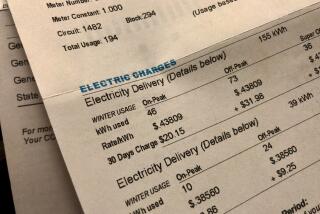Sifting the Chatter of Cell Phone Fees
- Share via
This time of year is prime selling season for the mobile phone world, and they make the most of it by trotting out fancy new phones and luring in customers with discounts and special service plans.
That’s all to the good for consumers, but it’s important not to get caught up in the holiday hoopla. Buying wireless phone service is a long-term commitment that lasts at least a year in most cases, and finding the right fit is essential.
The most important element is the service plan, which details the contract duration, the monthly fee, the features and amount of air time included each month and the rate you’ll pay for extras such as additional minutes of air time, directory assistance and long-distance calling.
In California, your choice of carriers includes AT&T; Wireless (formerly L.A. Cellular in Los Angeles), Nextel Communications, Pacific Bell Wireless (soon to be renamed Cingular Wireless), Sprint PCS and Verizon Wireless (formerly AirTouch and GTE Wireless). Those companies have their own retail outlets, but you can also buy service through specialty wireless shops, electronics and office supply stores, Costco, Wal-Mart and others.
First, consider how many minutes the phone will be used each month.
A so-called safety user buys a phone and service primarily to keep handy in case of emergencies, and thus should review plans with low monthly fees and a low number of built-in minutes, often 30 minutes or less.
An average user might make a mix of personal and business calls totaling 150 to 180 minutes each month, with some long-distance and other extras. The average monthly bill is about $45.
Heavy users tend to travel and consume a substantial number of wireless minutes, typically more than 1,000 minutes per month.
It’s important to review each carrier’s designated local calling area, the geographic region within which you can make and receive calls without incurring extra charges. Calls you make while traveling outside the region are usually subject to roaming charges and may also be subject to long-distance fees.
Some service plans come with a restricted local calling zone, while others contain regional or national territories with no roaming or long-distance fees.
Next, consider whether or how much you will use your mobile phone during weekday business hours (peak hours) compared with weekday evenings and weekends (nonpeak times). Some carriers sell plans with “any time” minutes; others charge more for peak-time usage.
Make sure you pick a carrier that will allow you to change plans without extra fees or an extension of your contract because your initial estimates may be wrong or your usage may change over time.
Buying into a plan with far too many or too few minutes is wasteful. Once you use up your monthly allotment of minutes, additional time can cost 25 cents or 35 cents per minute.
On the other hand, if you pay $40 per month for a plan with 200 minutes (equal to 20 cents per minute) but then use only half the allotment, you have effectively paid 40 cents per minute for your calls.
Lastly, if you plan to use directory assistance frequently, it’s worth checking the price, accuracy and refund procedure for that service. Some wireless companies charge 99 cents plus air time charges for information--a hefty fee that can really sting if you then get the wrong number.
And remember: It’s critical that you read the fine print because that’s where the unadvertised fees and add-on charges are detailed. Check whether the carrier charges a fee for early cancellation of the contract, and whether that fee is prorated depending on how long you retained service.
After you’ve narrowed your search to a few plans and carriers, it’s time to turn to another critical element: service coverage.
This is a tough one to evaluate, but it essentially determines where your phone will work, as well as the general quality of the connection.
Keep in mind that wireless service works by transmitting your voice or message through the air using radio waves, which travel from your phone to the carrier’s nearest antenna.
Radio waves are far from perfect, and the quality and breadth of coverage can vary by carrier.
Carriers typically present customers with a “coverage map,” which purports to detail where their service is available. These almost always are too vague to be useful, except to establish which cities have coverage for traveling purposes.
Think about where coverage will be important to you, such as where you drive, where you travel out of the region and where you work and live.
Press every carrier on the coverage issue. Make them promise that they will allow you to return the phone and cancel the service within a reasonable period if they do not deliver a signal in places important to you.
(BEGIN TEXT OF INFOBOX / INFOGRAPHIC)
The Plan That’s Right for You
Choosing a wireless service plan can take a bit of up-front research, but it’s worth it. Buying a plan and phone on impulse rarely gets you the best fit for your needs. Below, we’ve outlined some typical categories of cell phone users and listed the best Los Angeles-area plan available for each. In some cases, there were only slight differences in plans, so shop according to your individual characteristics.
The safety user: Someone who does not intend to make a habit of using his or her wireless phone. The phone is mainly for use in case of car trouble or other emergencies. Monthly usage: 20 to 30 minutes. Key needs: The cheaper the better.
The around town user: A new user who has gotten more and more addicted to the convenience of a wireless phone. Most teen customers fit into this category. Usage is mostly local. Monthly usage: 125 to 250 minutes. Key needs: Enough peak-time calling minutes.
The heavy user: A person who will use the mobile phone liberally for work and personal calling, mostly within his or her home region. Monthly usage: 400-plus minutes. Key needs: Lots of minutes, free long-distance from local calling area.
The business traveler: A person who travels frequently and uses his or her mobile phone as a business tool, making and receiving lots of calls throughout the day. Monthly usage: 600+ minutes. Key needs: Broad national coverage, large number of “any time” minutes, no long-distance or roaming charges.
More to Read
Inside the business of entertainment
The Wide Shot brings you news, analysis and insights on everything from streaming wars to production — and what it all means for the future.
You may occasionally receive promotional content from the Los Angeles Times.










